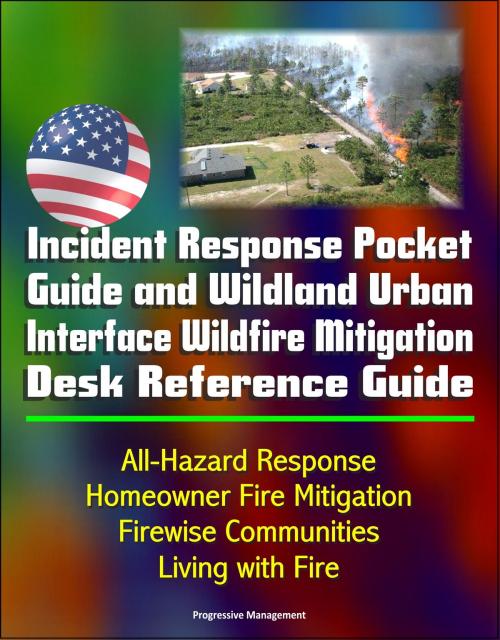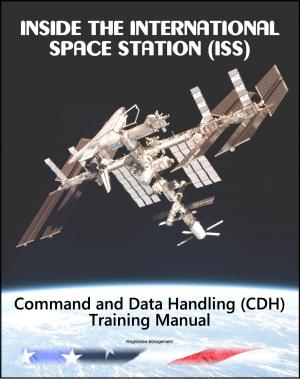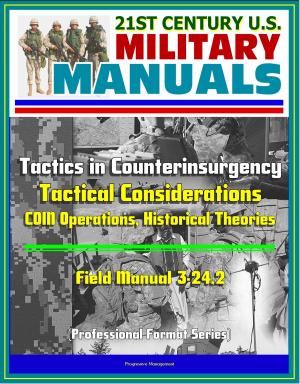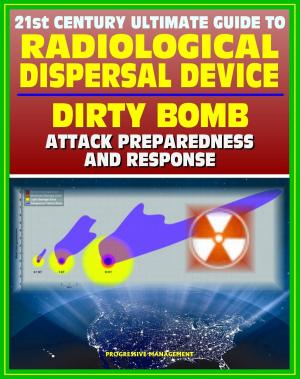Incident Response Pocket Guide and Wildland Urban Interface Wildfire Mitigation Desk Reference Guide: All-Hazard Response, Homeowner Fire Mitigation, Firewise Communities, Living with Fire
Nonfiction, Science & Nature, Technology, Fire Science, Social & Cultural Studies, Social Science| Author: | Progressive Management | ISBN: | 9781311089571 |
| Publisher: | Progressive Management | Publication: | September 28, 2014 |
| Imprint: | Smashwords Edition | Language: | English |
| Author: | Progressive Management |
| ISBN: | 9781311089571 |
| Publisher: | Progressive Management |
| Publication: | September 28, 2014 |
| Imprint: | Smashwords Edition |
| Language: | English |
This ebook reproduces two important wildfire and incident-response documents: Incident Response Pocket Guide and Wildland Urban Interface Wildfire Mitigation Desk Reference Guide.
Incident Response Pocket Guide - This reference is intended to assist in reporting key information regarding incident conditions when first arriving on-scene. All agencies will have specific information requirements that may involve additional reports. The intent of this guide is to provide a wildland fire job aid and training reference for operational personnel from Firefighter Type 2 through Division Supervisor and initial attack/extended attack Incident Commanders. It also has a secondary application for all-hazard incident response. Operational Leadership * Communication Responsibilities * Leader's Intent * Human Factor Barriers to Situation Awareness * After Action Review * OPERATIONAL ENGAGEMENT * Risk Management * Planning for Medical Emergencies * Look Up, Down and Around * Look Up, Down and Around (continued) * Common Denominators of Fire Behavior on Tragedy Fires * Common Tactical Hazards * LCES * Safety Zones * Downhill Checklist * Indicators of Incident Complexity * Wildland Urban Interface Firefighting * SPECIFIC HAZARDS * How to Properly Refuse Risk * Thunderstorm Safety * Hazard Tree Safety * Powerline Safety * Roadside Response Safety * Unexploded Ordnance Safety * Oil and Gas Site Safety * Last Resort Survival * ALL HAZARD RESPONSE * Vehicle Accident Operations * HazMat Incident Operations * HazMat Isolation Distances * HazMat Classification for Fixed Facilities based on NFPA 704 * Local Disaster Response * All Hazard Incident Response * Structure Hazard Marking System * Missing Person Search Urgency * AVIATION * Aviation User Checklist * Aviation Watch Out Situations * Helicopter Passenger Briefing and PPE * Flight Following * Helicopter Landing Area Selection * One-Way Helispot * Two-Way Helispot * Longline Mission * Helicopter Hand Signals * Paracargo Operations Safety * Weight Estimates * Aerial Retardant Safety * Directing Retardant and Bucket Drops * Working with Airtankers * Aircraft Mishap Response Actions * SAFECOM Reporting System * OTHER REFERENCES * Spot Weather Forecast * Energy Release Component (ERC) * Burning Index (BI) * Haines Index (HI) * Keetch-Byram Drought Index (KBDI) * Lightning Activity Level (LAL) * Weather Watch/Weather Warning * Wind Speed Ranges * Severe Fire Behavior Potential * Minimum Impact Suppression Tactics * Reporting Fire Chemical Introductions * Fire Cause Determination Checklist * Media Interviews * Phonetic Alphabet * EMERGENCY MEDICAL CARE GUIDELINES * Emergency Medical Care Guidelines * Patient Assessment * Specific Treatments * CPR * Heat-Related Injuries * Burn Injuries * Injury/Fatality Procedures * Medical Incident Report * Sizeup Report * Briefing Checklist * Standard Firefighting Orders *
Wildland Urban Interface Wildfire Mitigation Desk Reference Guide - The effects of wildland fire on communities have become more intense, frequent, and far-reaching. Increased development in the wildland urban interface means higher wildfire risk and more suppression needs, costing billions every year. This book is designed to provide basic background information on relevant programs and terminology for those, whether community members or agency personnel, who are seeking to enhance their community's wildfire mitigation efforts. Mitigation happens at all levels - local, state, tribal, and federal. This guide defines terms and identifies resources that are useful in mitigation planning efforts for all lands. The four primary objectives of this reference guide are to: Provide a reference to assist with integrating wildland urban interface mitigation principles into national wildland fire training; Promote common wildfire mitigation language and culture; Establish an authoritative source for wildland urban interface mitigation information; and Provide consistent definitions for use by all media.
This ebook reproduces two important wildfire and incident-response documents: Incident Response Pocket Guide and Wildland Urban Interface Wildfire Mitigation Desk Reference Guide.
Incident Response Pocket Guide - This reference is intended to assist in reporting key information regarding incident conditions when first arriving on-scene. All agencies will have specific information requirements that may involve additional reports. The intent of this guide is to provide a wildland fire job aid and training reference for operational personnel from Firefighter Type 2 through Division Supervisor and initial attack/extended attack Incident Commanders. It also has a secondary application for all-hazard incident response. Operational Leadership * Communication Responsibilities * Leader's Intent * Human Factor Barriers to Situation Awareness * After Action Review * OPERATIONAL ENGAGEMENT * Risk Management * Planning for Medical Emergencies * Look Up, Down and Around * Look Up, Down and Around (continued) * Common Denominators of Fire Behavior on Tragedy Fires * Common Tactical Hazards * LCES * Safety Zones * Downhill Checklist * Indicators of Incident Complexity * Wildland Urban Interface Firefighting * SPECIFIC HAZARDS * How to Properly Refuse Risk * Thunderstorm Safety * Hazard Tree Safety * Powerline Safety * Roadside Response Safety * Unexploded Ordnance Safety * Oil and Gas Site Safety * Last Resort Survival * ALL HAZARD RESPONSE * Vehicle Accident Operations * HazMat Incident Operations * HazMat Isolation Distances * HazMat Classification for Fixed Facilities based on NFPA 704 * Local Disaster Response * All Hazard Incident Response * Structure Hazard Marking System * Missing Person Search Urgency * AVIATION * Aviation User Checklist * Aviation Watch Out Situations * Helicopter Passenger Briefing and PPE * Flight Following * Helicopter Landing Area Selection * One-Way Helispot * Two-Way Helispot * Longline Mission * Helicopter Hand Signals * Paracargo Operations Safety * Weight Estimates * Aerial Retardant Safety * Directing Retardant and Bucket Drops * Working with Airtankers * Aircraft Mishap Response Actions * SAFECOM Reporting System * OTHER REFERENCES * Spot Weather Forecast * Energy Release Component (ERC) * Burning Index (BI) * Haines Index (HI) * Keetch-Byram Drought Index (KBDI) * Lightning Activity Level (LAL) * Weather Watch/Weather Warning * Wind Speed Ranges * Severe Fire Behavior Potential * Minimum Impact Suppression Tactics * Reporting Fire Chemical Introductions * Fire Cause Determination Checklist * Media Interviews * Phonetic Alphabet * EMERGENCY MEDICAL CARE GUIDELINES * Emergency Medical Care Guidelines * Patient Assessment * Specific Treatments * CPR * Heat-Related Injuries * Burn Injuries * Injury/Fatality Procedures * Medical Incident Report * Sizeup Report * Briefing Checklist * Standard Firefighting Orders *
Wildland Urban Interface Wildfire Mitigation Desk Reference Guide - The effects of wildland fire on communities have become more intense, frequent, and far-reaching. Increased development in the wildland urban interface means higher wildfire risk and more suppression needs, costing billions every year. This book is designed to provide basic background information on relevant programs and terminology for those, whether community members or agency personnel, who are seeking to enhance their community's wildfire mitigation efforts. Mitigation happens at all levels - local, state, tribal, and federal. This guide defines terms and identifies resources that are useful in mitigation planning efforts for all lands. The four primary objectives of this reference guide are to: Provide a reference to assist with integrating wildland urban interface mitigation principles into national wildland fire training; Promote common wildfire mitigation language and culture; Establish an authoritative source for wildland urban interface mitigation information; and Provide consistent definitions for use by all media.















